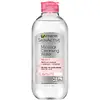What's inside
What's inside
 Key Ingredients
Key Ingredients

No key ingredients
 Benefits
Benefits

 Concerns
Concerns

No concerns
 Ingredients Side-by-side
Ingredients Side-by-side

Water
Skin ConditioningGlycerin
Humectant1,2-Hexanediol
Skin ConditioningDipropylene Glycol
HumectantPolyglyceryl-4 Caprate
EmulsifyingPolyglyceryl-6 Caprylate
EmulsifyingButylene Glycol
HumectantSorbitol
HumectantCoco-Betaine
CleansingSodium Citrate
BufferingPanthenol
Skin ConditioningSodium Chloride
MaskingCoco-Glucoside
CleansingEthylhexylglycerin
Skin ConditioningCitric Acid
BufferingDecyl Glucoside
CleansingDisodium EDTA
Caprylic/Capric Triglyceride
MaskingPropanediol
SolventCeramide NP
Skin ConditioningHydrogenated Lecithin
EmulsifyingHydroxyacetophenone
AntioxidantBifida Ferment Lysate
Skin ConditioningAngelica Archangelica Root Extract
MaskingAspalathus Linearis Leaf Extract
Skin ConditioningBambusa Vulgaris Leaf/Stem Extract
HumectantMalpighia Glabra Fruit Extract
Skin ConditioningCentella Asiatica Extract
CleansingWater, Glycerin, 1,2-Hexanediol, Dipropylene Glycol, Polyglyceryl-4 Caprate, Polyglyceryl-6 Caprylate, Butylene Glycol, Sorbitol, Coco-Betaine, Sodium Citrate, Panthenol, Sodium Chloride, Coco-Glucoside, Ethylhexylglycerin, Citric Acid, Decyl Glucoside, Disodium EDTA, Caprylic/Capric Triglyceride, Propanediol, Ceramide NP, Hydrogenated Lecithin, Hydroxyacetophenone, Bifida Ferment Lysate, Angelica Archangelica Root Extract, Aspalathus Linearis Leaf Extract, Bambusa Vulgaris Leaf/Stem Extract, Malpighia Glabra Fruit Extract, Centella Asiatica Extract
 Reviews
Reviews

Ingredients Explained
These ingredients are found in both products.
Ingredients higher up in an ingredient list are typically present in a larger amount.
Disodium EDTA plays a role in making products more stable by aiding other preservatives.
It is a chelating agent, meaning it neutralizes metal ions that may be found in a product.
Disodium EDTA is a salt of edetic acid and is found to be safe in cosmetic ingredients.
Learn more about Disodium EDTAGlycerin is already naturally found in your skin. It helps moisturize and protect your skin.
A study from 2016 found glycerin to be more effective as a humectant than AHAs and hyaluronic acid.
As a humectant, it helps the skin stay hydrated by pulling moisture to your skin. The low molecular weight of glycerin allows it to pull moisture into the deeper layers of your skin.
Hydrated skin improves your skin barrier; Your skin barrier helps protect against irritants and bacteria.
Glycerin has also been found to have antimicrobial and antiviral properties. Due to these properties, glycerin is often used in wound and burn treatments.
In cosmetics, glycerin is usually derived from plants such as soybean or palm. However, it can also be sourced from animals, such as tallow or animal fat.
This ingredient is organic, colorless, odorless, and non-toxic.
Glycerin is the name for this ingredient in American English. British English uses Glycerol/Glycerine.
Learn more about GlycerinWater. It's the most common cosmetic ingredient of all. You'll usually see it at the top of ingredient lists, meaning that it makes up the largest part of the product.
So why is it so popular? Water most often acts as a solvent - this means that it helps dissolve other ingredients into the formulation.
You'll also recognize water as that liquid we all need to stay alive. If you see this, drink a glass of water. Stay hydrated!
Learn more about Water